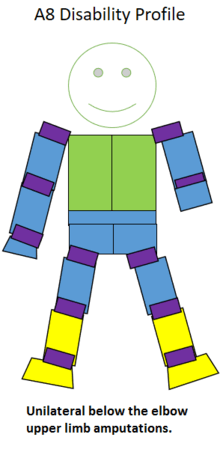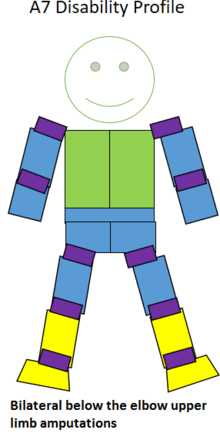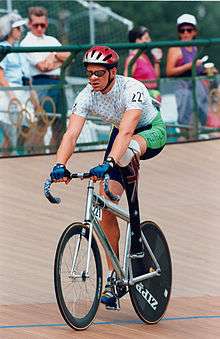LC1 (classification)
LC1 is a Paralympic cycling classification. It includes a number of types of people with disabilities including people with amputation and spinal cord injuries that are mostly confined to the upper limbs. This class includes people from the ISOD A5 class, A6 class, A7 class and A8 class.
Definition
This is a Paralympic cycling classification.[1] In 2000, BBC Sport defined this classification as "Amputee, Spinal Cord Injury and Les Autre competitors compete within the classification groupings LC1 - essentially for riders with upper limb disabilities,"[2] In 2008, BBC Sport defined this classification was "LC1: Riders with upper limb disabilities"[1] In 2008, the Australian Broadcasting Corporation defined this classification was "Locomotor Disabilities (LC): Cyclists with a physical disability compete in four classes - LC1, LC2, LC3, LC4 - based on functional ability, with separate events for men and women."[3] The Australian Paralympic Education Program defined this classification in 2012 as: "Riders with upper limb disabilities"[4] This class includes people from the ISOD A8 class.[5]
Disability groups
Amputees
Upper limb amputees


One of the groups of people competing in this class is people with upper limb amputations from ISOD A5, A6, A7 and A8 classes.[5] The nature of a person's amputations in this class can effect their physiology and sports performance. Because they are missing a limb, amputees are more prone to overuse injuries in their remaining limbs. Common problems for intact upper limbs for people in this class include rotator cuffs tearing, shoulder impingement, epicondylitis and peripheral nerve entrapment.[6]
Classification history
Cycling first became a Paralympic sport at the 1988 Summer Paralympics.[4] In September 2006, governance for para-cycling passed from the International Paralympic Committee's International Cycling Committee to UCI at a meeting in Switzerland. When this happened, the responsibility of classifying the sport also changed.[7]
For the 2016 Summer Paralympics in Rio, the International Paralympic Committee had a zero classification at the Games policy. This policy was put into place in 2014, with the goal of avoiding last minute changes in classes that would negatively impact athlete training preparations. All competitors needed to be internationally classified with their classification status confirmed prior to the Games, with exceptions to this policy being dealt with on a case by case basis.[8]
Events
Events for this classification include the 1 km Time Trial.[9]
Competitors

LC1 competitors include Mark Bristow from Great Britain who has won a gold medal at the Paralympics.[9]
Historical world records
Below are some historical world records for this classification in the 200m men's Indoor track / Flying start.[10]
| Time | Cyclist | Country | Classification | Date and location | Country location | Reference |
| 13"020 | Francisco Trujillo | FRA | LC 1 Bicycle | 02.06.1994 GENT | BEL | [10] |
| 12"310 | Wolfgang Eibeck | AUT | LC 1 Bicycle | 03.08.1995 AUGSBURG | GER | [10] |
Becoming classified
Classification is handled by Union Cycliste Internationale.[11] Classification generally has four phase. The first stage of classification is a health examination. For amputees, this is often done on site at a sports training facility or competition. The second stage is observation in practice, the third stage is observation in competition and the last stage is assigning the sportsperson to a relevant class.[12] Sometimes the health examination may not be done on site because the nature of the amputation could cause not physically visible alterations to the body.[13]
References
| Wikimedia Commons has media related to Cycling at the Paralympics. |
- 1 2 "A-Z of Paralympic classification". BBC Sport. 28 August 2008. Retrieved 9 April 2012.
- ↑ "Making sense of the categories". United Kingdom: BBC Sports. 6 October 2000. Retrieved 9 April 2012.
- ↑ McGarry, Andrew (3 September 2008). "Paralympics categories explained". Australian Broadcasting Corporation. Retrieved 9 April 2012.
- 1 2 "Cycling". Australian Paralympic Committee. 2012.
- 1 2 Bressan, ES (2008). "Striving for fairness in Paralympic sport-Support from applied sport science". Continuing Medical Education.
- ↑ Miller, Mark D.; Thompson, Stephen R. (2014-04-04). DeLee & Drez's Orthopaedic Sports Medicine. Elsevier Health Sciences. ISBN 9781455742219.
- ↑ "Para-cycling High Performance". Australia: Cycling Australia. Retrieved 14 June 2012.
- ↑ "Rio 2016 Classification Guide" (PDF). International Paralympic Committee. International Paralympic Committee. March 2016. Retrieved July 22, 2016.
- 1 2 "Cycling". British Paralympic Association. Retrieved 9 April 2012.
- 1 2 3 "Para-Cycling Track World Records Historical". UCI. Retrieved 14 June 2012.
- ↑ "Guide to the Paralympic Games – Appendix 1" (PDF). London Organising Committee of the Olympic and Paralympic Games. 2011. p. 42. Retrieved 9 April 2012.
- ↑ Tweedy, Sean M.; Beckman, Emma M.; Connick, Mark J. (August 2014). "Paralympic Classification: Conceptual Basis, Current Methods, and Research Update" (PDF). Paralympic Sports Medicine and Science. 6 (85). Retrieved July 25, 2016.
- ↑ Gilbert, Keith; Schantz, Otto J.; Schantz, Otto (2008-01-01). The Paralympic Games: Empowerment Or Side Show?. Meyer & Meyer Verlag. ISBN 9781841262659.
.svg.png)